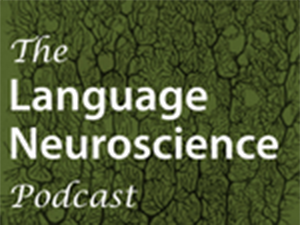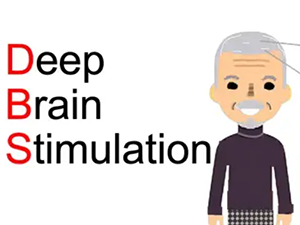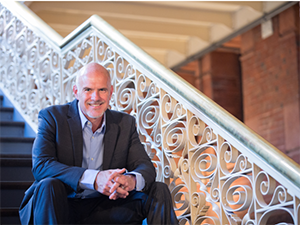2021 Media
- The Building Blocks of Language
- Neuromodulation on The Language Neuroscience Podcast
- Neuromodec Highlights the Use of Wearables During Parkinson's Disease Awareness Month
- Michael Platt Investigates Primate Behaviors Related to Natural Disasters
- People Magazine Talks to brainSTIM's Yvette Sheline, MD
- 'Perspective Taking' and the Secret to Problem Solving
- WIRED Talks to Danielle Bassett, PhD, as it Examines the Importance of Representation in STEM
- Ana Maiques: El País con Tu Futuro
- brainSTIM Welcomes New Affiliated Scientists
- Center Highlight Archive
The Building Blocks of Language
 On NPR's The Pulse podcast, Dr. Roy Hamilton shares how he is currently studying the use of Transcranial Magnetic Stimulation (TMS) to help people with post-stroke aphasia.
On NPR's The Pulse podcast, Dr. Roy Hamilton shares how he is currently studying the use of Transcranial Magnetic Stimulation (TMS) to help people with post-stroke aphasia.
Neuromodulation on The Language Neuroscience Podcast
 brainSTIM Director Roy Hamilton, MD, MS sits down with host Stephen M. Wilson of the Language Neuroscience Podcast to discuss his work in transcranial magnetic stimulation (TMS), transcranial direct current stimulation (tDCS), and the application of such neuromodulatory techniques to enhance recovery in patients suffering from aphasia. Click below to listen to the full podcast episode.
brainSTIM Director Roy Hamilton, MD, MS sits down with host Stephen M. Wilson of the Language Neuroscience Podcast to discuss his work in transcranial magnetic stimulation (TMS), transcranial direct current stimulation (tDCS), and the application of such neuromodulatory techniques to enhance recovery in patients suffering from aphasia. Click below to listen to the full podcast episode.
Neuromodec Highlights the Use of Wearables During Parkinson's Disease Awareness Month
 For Parkinson's Disease Awareness Month, Neuromodec partnered with NeuroTech Network in April to highlight the expansion of Neurotech options for those with Parkinson's Disease.
For Parkinson's Disease Awareness Month, Neuromodec partnered with NeuroTech Network in April to highlight the expansion of Neurotech options for those with Parkinson's Disease.
Neuromodec, founded by brainSTIM External Advisory Board member Marom Bikson, PhD, sought to highlight the use of deep brain stimulation in treating symptoms of Parkinson's Disease. Deep brain stimulation, which is a medical device therapy requiring surgery to implant a neurostimulator in the upper chest, can lead to improvements in social, occupational, and psychosocial function.
Over the years, several other device-based therapies have been developed to treat the symptoms of Parkinson's Disease, including focused ultrasound treatment (FUS), which allow for those with Parkinson's Disease to explore alternative therapies. Wearable neuromodulation technologies have also been emerging as a viable option in treating tremors. One device, under development from Encora Technologies, even uses artificial intelligence to sense real-time tremor severity and deliver an adaptable stimulus accordingly to control stiffness or tremors.
As research and development of more NeuroTech and wearable devices continue, people with Parkinson's Disease will be able to have an improved quality of life and will be able to have increased options for which device or therapy is most suited for their social, occupational, and functional needs.
Michael Platt Investigates Primate Behaviors Related to Natural Disasters
 How do natural disasters shape the behavior and social networks of rhesus macaques?
How do natural disasters shape the behavior and social networks of rhesus macaques?
In a new profile piece from PennToday, brainSTIM Faculty Steering Committee member Michael Platt, PhD, and his team of researchers are highlighted regarding their work in studying a colony of rhesus macaques on Cayo Santiago in Puerto Rico.
The study, which had been in progress for a decade, was brought in a new direction by the effects of Hurricane Maria. The hurricane, which hit Cayo Santiago in 2017, devastated the island and left researchers on the ground scrambling to rebuild the study. However, they received the unique opportunity to study the change in social patterns amongst the rhesus macaques colony in response to the natural disaster.
The researchers were interested in seeing how the monkeys' social patterns would shift in response to the hurricane. Instead of becoming more aggressive or territorial regarding the depletion of resources on the island and the increased competition for food, the monkeys instead became more social and more accepting of one another, and built new relationships. In response to the natural disaster, the monkeys expanded their social networks and relied on community, rather than isolating themselves or their existing social circles.
To learn more about the rhesus macaques' change in social patterns following the hurricane, and to learn about how the researchers had to change their traditional methods of sampling and observation following Hurricane Maria, click the link below.
People Magazine Talks to brainSTIM's Yvette Sheline, MD
 In a new profile piece, People Magazine speaks with writer Jenny Lawson about her new memoir, where she highlights her battle with depression. In her work, Lawson shares her struggles with mental health, and how her experience with transcranial magnetic stimulation (TMS), changed her life.
In a new profile piece, People Magazine speaks with writer Jenny Lawson about her new memoir, where she highlights her battle with depression. In her work, Lawson shares her struggles with mental health, and how her experience with transcranial magnetic stimulation (TMS), changed her life.
In her memoir, the author reveals to readers her lifelong struggle with treatment-resistant depression and anxiety, and how her first TMS treatments in 2018 allowed her to reclaim her life, and even manage her anxiety enough to take a family trip to Europe.
In conjunction with Lawson's story, People reached out to Yvette Sheline, MD, Director of Penn's Center for Neuromodulation in Depression and Stress and member of brainSTIM's Faculty Steering Committee, to further explain and demystify the concept and process of TMS to its readers.
To read Dr. Sheline's full contribution and learn more about Jenny Lawson's experience with TMS, read the full article below.
As a James S. Riepe Penn Integrates Knowledge Professor of Marketing, Psychology, and Neuroscience, Dr. Platt has taken his extensive research into understanding how the human brain works, and has translated that into strategies that will help businesspeople get ahead in the workplace. When speaking with Wharton School Press, Dr. Platt details how his interdisciplinary work allows him to analyze business and leadership from a unique perspective.
"How can we use that information and the insights from these different disciplines...to address some of the biggest challenges facing business and facing society at large?" Dr. Platt questions, emphasizing the importance of bridging the gap between psychology, marketing, and neuroscience. Dr. Platt details some insights from his research that he has applied to his own work as a leader and director, and stresses the importance of those in leadership using their roles to connect with those they manage and create efficient and effective environments with high group morale.
When pondering the possible future intersections of neuroscience and business, Dr. Platt expresses excitement for the development of "critically important" wearable brain monitoring technologies, which will allow individuals to access and understand what goes on in their heads, and channel this information into improving their own performances.
'Perspective Taking' and the Secret to Problem Solving
 Michael Platt, PhD, Examines Decision Making Techniques
Michael Platt, PhD, Examines Decision Making Techniques
In a recent article, Wharton School Press examines how communication, collaboration, and innovation between parties can be improved both inside and outside of business contexts through the method of 'perspective taking'. This method, where an individual seeks to put oneself in another's shoes, can be used in a variety of settings to improve relations between coworkers and between companies as a whole, and help to drive business outcomes. To examine this concept, Wharton School Press spoke to Wharton Neuroscience Initiative Director Michael Platt, PhD.
Dr. Platt, who is also a noted member of brainSTIM Faculty Steering Committee, presented a study conducted by PlattLabs which examines how the human brain works differently when considering an issue from another perspective. When considering a problem by oneself, an individual activates a completely different network of the brain than when another person's point of view is considered. In PlattLabs' examination, they have found that by activating these other networks in environments that require decision making or communications, humans find it easier to be creative, learn new jobs, experiment, innovate, and generate new ideas without as much inhibition.
To read Wharton School Press' full examination of perspective taking, follow the link below.
WIRED Talks to Danielle Bassett, PhD, as it Examines the Importance of Representation in STEM
 Women in STEM: Redefining Mentorship
Women in STEM: Redefining Mentorship
In a new WIRED piece, the publication explores how representation matters to women interested in entering STEM fields. It is extremely important for those interested in STEM to find mentors in their field of study, but women often find themselves without other female mentors to look to for support and assistance. This calls into question the relationship between gender and academia.
In their examination, WIRED cites a paper published released by researchers at NYU Abu Dhabi which suggested that women in STEM should seek out men as mentors, with the reasoning that papers with male co-authors receive higher numbers of citations. The publication received a huge amount of backlash, which ultimately resulted in the paper's retraction.
WIRED spoke to brainSTIM Faculty Steering Committee member Danielle Bassett, PhD, regarding the disparity between the citation rates of publications with female authors versus those with male authors. Dr. Bassett points out that publications with male authors generally receive disproportionally higher citations rates in comparison to those written by their female counterparts because other male scientists preferentially cite them. She asserts that to use reasoning to encourage women entering STEM to seek male mentors would be a mistake.
WIRED examines the benefits for scientists who choose mentors who match their own demographics. By having support from somebody who shares a demographic or has experienced similar circumstances, young scientists can benefit both academically and emotionally, and can feel more motivated and comfortable in pursuing their studies.
To read the full article, click below.
Ana Maiques: El País con Tu Futuro
 In December, Neuroelectrics CEO and brainSTIM External Advisory Board Member presented at the El País con Tu Futuro, or "The Country of Your Future" Conference, which was recently shared publicly by Neuroelectrics.
In December, Neuroelectrics CEO and brainSTIM External Advisory Board Member presented at the El País con Tu Futuro, or "The Country of Your Future" Conference, which was recently shared publicly by Neuroelectrics.
In her presentation, Maiques shared her life story, and how she was able to achieve her dream and further her career with students and watchers. She begins by outlining her dreams as a young adult to forge her way as an entrepreneur, as well as her early days at Starlab whilst investigating space and neuroscience.
Additionally, Maiques goes into details regarding her interest into creating technologies and devices that monitor brain activity in a general sense, but can also be used to monitor brain function in patients with Alzheimer's disease, epilepsy, and other conditions. By monitoring brain function, individualized therapies can be created to improve patients' quality of life, or even affect brain function.
Maiques closed by reiterating why she has taken the path that she has, and emphasizes her want to make a difference and a positive impact on both patients and on those in her field. She expressed a positive outlook for the future and encouraged those watching to go after their dreams, just as she did.
To watch Maiques' full presentation, click above or the link below.
brainSTIM Welcomes New Affiliated Scientists
The Penn brainSTIM Center is pleased to welcome several new Affiliated Scientists to our brainSTIM family.
Our new affiliates include Russell Epstein, PhD, Emily Falk, PhD, Martha J. Farah, PhD, and Adrian Raine. Read below to find our more about our new affiliates and how their research and missions align with that of brainSTIM.
 Russell Epstein, PhD, is a Professor of Psychology at the University of Pennsylvania. Dr. Epstein directs the University of Pennsylvania's Epstein Lab, where he leads a team in studying both perception, memory, and the neural mechanisms underlying visual scene perception, event perception, object recognition, and spatial navigation in humans.
Russell Epstein, PhD, is a Professor of Psychology at the University of Pennsylvania. Dr. Epstein directs the University of Pennsylvania's Epstein Lab, where he leads a team in studying both perception, memory, and the neural mechanisms underlying visual scene perception, event perception, object recognition, and spatial navigation in humans.
Learn More About the Epstein Lab Here
 Emily Falk, PhD, is a Professor of Communication, Psychology, and Marketing at the University of Pennsylvania. Dr. Falk directs Penn's Communication Neuroscience Lab, and is a Distinguished Fellow of the Annenberg Public Policy Center.
Emily Falk, PhD, is a Professor of Communication, Psychology, and Marketing at the University of Pennsylvania. Dr. Falk directs Penn's Communication Neuroscience Lab, and is a Distinguished Fellow of the Annenberg Public Policy Center.
Dr. Falk's research interests include behavior change, persuasion, and how ideas and behaviors spread. She is an expert in the science of behavior change, and uses psychology, neuroscience, and communication to examine what makes messages persuasive, why and how ideas spread, and what makes people effective communicators.
Learn More About the Communication Neuroscience Lab Here
![]() Martha J. Farah, PhD, is a Walter H. Annenberg Professor of Natural Sciences and Professor of Psychology at the University of Pennsylvania, with secondary appointments in Neurology and the Graduate School of Education. Dr. Farah also directs the Center for Cognitive Neuroscience (CCN), as well as the Center for Neuroscience & Society (CNS) at the University of Pennsylvania.
Martha J. Farah, PhD, is a Walter H. Annenberg Professor of Natural Sciences and Professor of Psychology at the University of Pennsylvania, with secondary appointments in Neurology and the Graduate School of Education. Dr. Farah also directs the Center for Cognitive Neuroscience (CCN), as well as the Center for Neuroscience & Society (CNS) at the University of Pennsylvania.
Dr. Farah is a cognitive neuroscientist with interests in the problems at the interface between neuroscience and society, which includes the effects of childhood poverty on brain development, the expanding use of neuropsychiatric medications by healthy people for brain enhancement, novel uses of brain imaging, in e.g. legal, diagnostic and educational contexts, and the many ways in which neuroscience is changing the way we think of ourselves as physical, mental, moral and spiritual being.
Learn More About the Center for Neuroscience & Society Here
 Adrian Raine, PhD, is the Richard Perry University Professor of Criminology, Psychiatry, and Psychology at the University of Pennsylvania. His interdisciplinary research focuses on the etiology and prevention of antisocial, violent, and psychopathic behavior in children and adults, including biological interventions to reduce aggressive and antisocial behavior. His three neuromodulation studies to date in both community participants and prisoners have focused on modulation of prefrontal cortical activity to reduce aggression and upregulate moral decision-making.
Adrian Raine, PhD, is the Richard Perry University Professor of Criminology, Psychiatry, and Psychology at the University of Pennsylvania. His interdisciplinary research focuses on the etiology and prevention of antisocial, violent, and psychopathic behavior in children and adults, including biological interventions to reduce aggressive and antisocial behavior. His three neuromodulation studies to date in both community participants and prisoners have focused on modulation of prefrontal cortical activity to reduce aggression and upregulate moral decision-making.
Learn More About Dr. Raine Here
The Penn brainSTIM Center is pleased and honored to have these individuals as affiliates, and looks forward to working with them in the future.
Center Highlight Archive
 Desmond Oathes, PhD, is a licensed Clinical Psychologist (CA), and is an Assistant Professor of Clinical Psychology in the Department of Psychiatry at the University of Pennsylvania. He is also the Associate Director of Penn’s Center for Neuromodulation in Depression & Stress (CNDS), and is the Principal Investigator at the Oathes Lab. Dr. Oathes’ primary research interests include the study and treatment of depression, PTSD, and adult ADHD.
Desmond Oathes, PhD, is a licensed Clinical Psychologist (CA), and is an Assistant Professor of Clinical Psychology in the Department of Psychiatry at the University of Pennsylvania. He is also the Associate Director of Penn’s Center for Neuromodulation in Depression & Stress (CNDS), and is the Principal Investigator at the Oathes Lab. Dr. Oathes’ primary research interests include the study and treatment of depression, PTSD, and adult ADHD.
Having always found human minds to be fascinating, Dr. Oathes thought to become a Clinical Psychologist upon entering college. With support from his mother, Dr. Oathes began pursuing his BA in Psychology at the California State University (Hayward, CA). While taking experimental methods classes, he found a particular interest in designing experiments, and enjoyed the logic involved in designing experiments to support conclusions. After receiving his BA in Psychology from California State University, Dr. Oathes went on to acquire his MS in Psychology and PhD in Clinical Psychology from Pennsylvania State University.
While in graduate school, Dr. Oathes studied and experimented with electroencephalography (EEG), heart rate variability, pupillography, and transcranial magnetic stimulation (TMS). However, Dr. Oathes found a concerted interest in studying brain activity using functional magnetic resonance imaging (fMRI), which was unavailable at the time at Penn State. To further study the use of fMRI, Dr. Oathes completed his postdoctoral fellowship at the University of Wisconsin. During his time there, he focused on utilizing functional imaging of generalized anxiety disorder, and combined the use of TMS with fMRI upon completing his second postdoctoral fellowship at Stanford University.
Early in his research, Oathes focused on how different forms of mental illness could be distinguished from one another using imaging and other tools. His research is also influenced by his work as a clinical psychologist, where seeing many patients with the same diagnosis but with different histories and experiences inspired him to pursue individualized TMS targeting to treat patients. Dr. Oathes also aims to translate neuroimaging studies into clinically actionable strategies for patients, which is being sought through combining knowledge from nomothetic databases to understand idiographic brain signatures.
In the long term, the Oathes Lab hopes to promote the wider use of interleaved TMS/fMRI to test theories of causal brain communication. Dr. Oathes also expresses a want to deepen the understanding of how successful treatment alters brain function, and how to apply this knowledge to tailor brain stimulation treatments to specific brain areas, functional impairments, and individual patients. On a larger scale, Dr. Oathes would like to increase sophistication in applying machine learning to brain stimulation targeting and imaging analysis, as well as exploring measurement tools, behavioral approaches, as well as newer forms of TMS and new stimulation tools. Dr. Oathes would like to see Penn become a training center for noninvasive brain stimulation methods so that knowledge can be shared between the next generation of scientists and clinicians toward the implementation of these tools.
Currently, the Center for Neuromodulation in Depression and Stress (CNDS) is combining diffusion imaging with Network Control Theory from engineering to hypothesize which brain areas are especially likely to exert control over others. Dr. Oathes also has multiple collaborations in the works, including those with fellow brainSTIM faculty steering committee members Ted Satterthwaite, MD, and Danielle Bassett, PhD, which focuses on working memory, interleaved TMS/fMRI, and rTMS neuromodulation. Dr. Oathes is also collaborating with University of Pennsylvania Associate Professor of Radiology Yong Fan, PhD, to use deep learning to determine brain stimulation targets and set up real-time fMRI feedback to drive working memory related brain areas into optimal states. Additionally, he is also collaborating with the CNDS’ Yvette Sheline, MD, and Wharton Neuroscience’s Michael Platt, PhD.
Dr. Oathes expresses the want to further collaborate with fellow members of brainSTIM’s faculty steering committee, and is excited for brainSTIM’s upcoming MINS Year of Neuromodulation. He also highlights the CNDS’ upcoming speaker series ‘The Neuromodulation & Neuroimaging Relevant to Affective Disorders Speaker Series’, which will kick off May 12, 2021 at 1:30PM with the University of Minnesota’s Professor of Biomedical Engineering Alexander Opitz, PhD, who will present ‘Leveraging a better understanding of non-invasive neuromodulation for improved stimulation protocols’.
To learn more about the CNDS and the Oathes Lab, click here.
To get updates about the CNDS’ speaker series, follow Dr. Oathes on Twitter here.
To tune in to Alexander Opitz, PhD’s presentation on May 12, click here.
April 2021 - John Medaglia, PhD
The brainSTIM Center's faculty highlight shines a light on the exciting research and work our core faculty have been doing both inside and outside of their labs and practices. April 2021’s highlight features John Medaglia, PhD.
 John Medaglia is an Assistant Professor of Psychology and Neurology at Drexel University, and is also an Adjunct Assistant Professor of Neurology at the University of Pennsylvania. Dr. Medaglia is the Director of Drexel University’s Cognitive Neuroengineering and Wellbeing Lab (CogNeW), as well as a Co-Primary Investigator at Penn’s Laboratory for Cognition and Neural Stimulation. Dr. Medaglia’s research interests primarily concern the use of network techniques to inform practical personalized approaches to leverage brain stimulation in experimental and clinical environments, as well as querying as to how control theory can guide noninvasive brain interventions, as well as how to use brain stimulation to improve treatments and promote quality of life for patients.
John Medaglia is an Assistant Professor of Psychology and Neurology at Drexel University, and is also an Adjunct Assistant Professor of Neurology at the University of Pennsylvania. Dr. Medaglia is the Director of Drexel University’s Cognitive Neuroengineering and Wellbeing Lab (CogNeW), as well as a Co-Primary Investigator at Penn’s Laboratory for Cognition and Neural Stimulation. Dr. Medaglia’s research interests primarily concern the use of network techniques to inform practical personalized approaches to leverage brain stimulation in experimental and clinical environments, as well as querying as to how control theory can guide noninvasive brain interventions, as well as how to use brain stimulation to improve treatments and promote quality of life for patients.
After receiving his BS in Psychology from Drexel University, Dr. Medaglia decided to pursue a graduate degree in neuroscience, which had piqued his interest as an undergrad. Having always been interested in becoming a professor, he obtained his PhD in clinical neuropsychology from Pennsylvania State University, and completed his postdoctoral training at Moss Rehabilitation Research Institute with fellow brainSTIM members Roy Hamilton, Danielle Bassett, and Sharon Thompson-Schill.
Prior to entering his graduate program, Dr. Medaglia considered a career in talk therapy, but found an interest in the brain basis of disorders. During his PhD training, he was drawn to brain network modeling as a pathway to develop neuromodulation treatments. While completing his postdoctoral training, Dr. Medaglia’s interest in neuromodulation and network control theory progressed as he and brainSTIM Director Roy Hamilton used network-guided techniques to determine how individual differences in network connectivity at a particular region in the brain could influence outcomes in study subjects.
As Director of Drexel University’s Cognitive Neuroengineering and Wellbeing Lab (CogNeW), Dr. Medaglia and his team focus on how modulation targets can be selected individually rather than based on large scale data sets. Currently, CogNeW is conducting a study in which participants perform well controlled behavioral tasks to help researchers further understand attraction functions. The laboratory is also conducting a study concerning neuroethics and how people perceive and make decisions regarding neuromodulation, and how they are evaluated by clinicians in relation to neuromodulation eligibility.
Dr. Medaglia has many long-term goals set for himself, his research, and for CogNeW. He hopes to increase collaboration between CogNeW and his peers at both Drexel and Penn, and voices an interest in working with those coming from a wide range of disciplines. He would also like to generate many interdisciplinary approaches to psychology within his own laboratory through encouraging collaboration between his team of engineers, computer scientists, and those with other core technical training, and voices an interest in taking CogNeW in a direction geared toward neuroengineering. Dr. Medaglia also emphasizes the importance of continuing to strive and be proactive in creating and sustaining a diverse and inclusive environment both in his lab, and in academia as a whole to generate novel ideas and approaches in a variety of disciplines.
In line with his interest in working with those from a variety of research backgrounds, Dr. Medaglia voices his excitement regarding his involvement with the Penn brainSTIM Center, as well as for the current collaborations he is involved in with fellow brainSTIM faculty. He and fellow brainSTIM Faculty Steering Committee member Flavia Vitale, PhD, have been collaborating on advancing the use of MXene bioelectronics in noninvasive brain monitoring and stimulation technologies. These nanomaterials can be used to develop the next generation of electrodes in electroencephalography (EEG), transcranial electrical stimulation (tES), and other neuromodulation technologies. In addition to his work with Dr. Vitale, Dr. Medaglia is also conducting a study with brainSTIM Director Roy Hamilton, MD, MS, Faculty Steering Committee member Branch Coslett, MD, as well as Georgetown University’s Peter Turkeltaub, PhD, which centralizes data analysis to test if network measures can be used to locate bottlenecks in the brain or precisely target individual areas of the brain. This study, primarily conducted in participants suffering from aphasia due to stroke, aims to determine how the language system reorganizes after injury, and whether brain stimulation can be employed to modulate and enhance recovery.
Through his work at CogNeW and at brainSTIM, Dr. Medaglia hopes to continue to foster collaboration, inclusivity, and work to further understand basic questions in psychology and neuroscience to optimize and help to individualize neuromodulation techniques, technologies, and treatments. He voices his want to affect patient outcomes and quality of life, and seeks to continue to study and apply his research interests in the future.
February 2021 - Ted Satterthwaite, MD

The brainSTIM Center's faculty highlight features Ted Satterthwaite, MD, is an Associate Professor of Psychiatry at the University of Pennsylvania Perelman School of Medicine, and is both a practicing physician at the Hospital of the University of Pennsylvania and Director of the University of Pennsylvania’s Lifespan Informatics & Neuroimaging Center (LINC). Dr. Satterthwaite’s research interests revolve around using multimodal neuroimaging and software to study both normal and abnormal patterns of brain development. Specifically, he uses large-scale studies of the developing brain to understand heterogeneity within current clinical diagnostic categories.
After receiving his BA from Williams College, Dr. Satterthwaite completed his medical and graduate training at Washington University in St. Louis. Originally, Dr. Satterthwaite wanted to become a neurologist, but ultimately pursued psychiatry upon realizing his interests focused on the aspects of the brain that were more behavioral. He went on to complete his psychiatric residency and a neuropsychiatric fellowship at Penn.
Though Dr. Satterthwaite focuses more on his research work in brain development, and specifically that of executive dysfunction or problems related to heterogeneity, he finds that his clinical work influences his research in many ways. Upon seeing his patients, Dr. Satterthwaite would often find that many would come in with a mix of symptoms that did not cleanly map onto the Diagnostic and Statistical Manual of Mental Disorders (DSM), or that could be associated with more than one diagnoses. These occurrences informed Dr. Satterthwaite’s interests in understanding how methods like non-invasive neuroimaging might help improve specificity and also parse heterogeneity within standard clinical diagnoses. However, such research requires very large datasets, which has led him to focus on “neuroinformatics” – the process of aggregating, curating, processing, and analyzing diverse, large-scale neuroimaging datasets.
At the Lifespan Informatics & Neuroimaging Center (LINC), Dr. Satterthwaite primarily employs noninvasive MRI based imaging modalities in his research, including T1 weighted imaging of brain structure, functional MRI, diffusion imaging of white matter, and arterial spin-labeled imaging of cerebral profusion. Currently, these technologies are employed in creating large scale data sets to identify complex patterns in brain development, and use this to inform and individualize prognoses and clinical treatments.
Dr. Satterthwaite and his team at LINC are currently participating in a wide variety of studies, and constantly work to create generalizable and reproducible software that can be widely used by the international research community. Two examples of these efforts include the eXtensible Connectivity Pipelines (for fMRI) and QSIPrep (for diffusion imaging) which have each been downloaded by thousands of researchers from around the world.
In one current study, called the “Reproducible Brain Charts” initiative, Dr. Satterthwaite’s team, together with Child Mind Institute’s Michael Milham, MD, PhD, are working to create a large-scale public data resource to study the developing brain. As part of this initiative, the collaborative group will release fully processed and carefully curated data from many diverse studies involving over 10,000 participants with ages ranging from 5-23 years old.
Dr. Satterthwaite’s collaborations also extend within the brainSTIM community. In one study, he and fellow brainSTIM Faculty Steering Committee member Danielle Bassett, PhD, are currently researching executive development in children. Furthermore, Dr. Satterthwaite and Dr. Bassett are also working on a study led by brainSTIM Faculty Steering Committee Member Desmond Oathes, PhD, which seeks to use neuroimaging to enhance and improve targeting techniques in TMS. Dr. Satterthwaite expresses optimism regarding these current collaborations and hopes to further foster collaboration across faculty members and disciplines in brainSTIM’s future.
Learn More About Penn LINC Here

